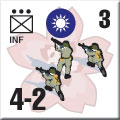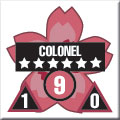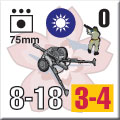Changsha Operation
Scenario Preview, Part Two
by Mike Bennighof, Ph.D.
February 2022
Panzer Grenadier: Changsha Operation is a special expansion set exclusively for our Gold Club. It’s not for sale, and won’t be offered to anyone else. It’s a download, with 88 new Panzer Grenadier pieces and eight new scenarios. You’ll have to assemble the pieces, and you’ll need Korean War: Pusan Perimeter and Korean War: Counter Attack for the maps.
 We’ve taken Panzer Grenadier all over the world, even to South America (War on the Equator), so I suppose it was inevitable that we eventually had to go to China. I want the series to involve every theater of the war, and cover all types of tactical combat. Those are stories I want to tell. We’ve taken Panzer Grenadier all over the world, even to South America (War on the Equator), so I suppose it was inevitable that we eventually had to go to China. I want the series to involve every theater of the war, and cover all types of tactical combat. Those are stories I want to tell.
The problem, of course, if that while I want to tell those stories, not enough people want to buy them. Sure, we had plenty of requests from Panzer Grenadier players who wanted to see a game or expansion set that was set in China. But I’ve learned, to my deep regret, that “I’d like to see” is not the same as “I will definitely buy.”
 Our new addition of Golden Gifts to the many things we give our Gold Club seems to have solved that problem. We can make expansion sets (and even complete games) and then just give them to the Gold Club in downloadable form. Once we’ve done that, the download can never be printed in hard-copy format – I know all about “I would gladly pay.” No, you would not. Our new addition of Golden Gifts to the many things we give our Gold Club seems to have solved that problem. We can make expansion sets (and even complete games) and then just give them to the Gold Club in downloadable form. Once we’ve done that, the download can never be printed in hard-copy format – I know all about “I would gladly pay.” No, you would not.
So far, this has been a therapeutic exercise in letting go, to admitting that I’m never going to publish a Panzer Grenadier expansion set in the War of Resistance. And by not worrying about how I might manage to publish it and convince people to buy it, I could just delve into the topic and craft what I think is a fine game of platoon-level combat between China and Japan in 1941. I like exploring topics that are new to me, and I managed to uncover some good source material in languages that I can read (all of them European).
 It was a different sort of war from that waged in the European theater, and so Changsha Operation makes for a different sort of Panzer Grenadier game. I didn’t want to go too deeply into “national differences,” like some wargames did in the less-enlightened past with rules that bordered on ethnic and racial stereotypes. Panzer Grenadier is what we in the trade call a “rugged” game system, in that it can simulate a lot without needing heavy modifications, and Changsha Operation has perhaps the shortest Special Rules section of any Panzer Grenadier game (the lack of motor vehicles in any of the scenarios has a lot to do with that). As a designer, you can show a lot of the differences between armies with elements already present in the game: initiative, morale, number of ability of leaders, the spread of leader ranks and even victory conditions (some armies care more about casualties than others). If you find yourself writing lots of special rules, then there’s probably something wrong with your underlying model. It was a different sort of war from that waged in the European theater, and so Changsha Operation makes for a different sort of Panzer Grenadier game. I didn’t want to go too deeply into “national differences,” like some wargames did in the less-enlightened past with rules that bordered on ethnic and racial stereotypes. Panzer Grenadier is what we in the trade call a “rugged” game system, in that it can simulate a lot without needing heavy modifications, and Changsha Operation has perhaps the shortest Special Rules section of any Panzer Grenadier game (the lack of motor vehicles in any of the scenarios has a lot to do with that). As a designer, you can show a lot of the differences between armies with elements already present in the game: initiative, morale, number of ability of leaders, the spread of leader ranks and even victory conditions (some armies care more about casualties than others). If you find yourself writing lots of special rules, then there’s probably something wrong with your underlying model.
So let’s have a look at the rest of the scenarios in Changsha Operation. You can read about the first five of them here.
Scenario Six
Clash at Dawn
6 January 1942
 The aggressive Japanese advance on Changsha had left the 11th Army with a vulnerable rear flank, and the armies of the Chinese IX War Zone soon filtered in behind the Japanese. The weak Japanese flank guards fought to keep the retreat route open as the conquerors of Changsha hurriedly abandoned their prize and marched back to the north. The aggressive Japanese advance on Changsha had left the 11th Army with a vulnerable rear flank, and the armies of the Chinese IX War Zone soon filtered in behind the Japanese. The weak Japanese flank guards fought to keep the retreat route open as the conquerors of Changsha hurriedly abandoned their prize and marched back to the north.
Conclusion
The Chinese kept up their attacks through the morning, but could not get past the Japanese blocking force to interrupt the enemy’s line of retreat. The Japanese had advanced without really paying much attention to the Chinese divisions left behind them, and Pi Yueh’s IX War Zone now directed them to block their escape. The Japanese Eleventh Army remained in grave danger.
Notes
This is a meeting engagement, with the Chinese trying to force their way up a narrow pass and the Japanese attempting to block them. The Japanese have the option to try outflanking the Chinese, but the Chinese may not care particularly. The Chinese actually have some support weapons this time, as do the Japanese, but like all the scenarios in this set this battle is going top be decided by the infantry.
Scenario Seven
Attack at Hsinkaishih
9 January 1942
 The Tozono Detachment, a single infantry battalion from the 18th Independent Mixed Brigade, rushed southward to help hold open 11th Army’s retreat route. Ordered to hold their ground, when they met advancing troops of the Chinese 99th Army they of course immediately attacked them. The Tozono Detachment, a single infantry battalion from the 18th Independent Mixed Brigade, rushed southward to help hold open 11th Army’s retreat route. Ordered to hold their ground, when they met advancing troops of the Chinese 99th Army they of course immediately attacked them.
Conclusion
The Japanese attack did stop the Chinese advance, but at a heavy cost. The Tozono Detachment remained tangled with the Chinese for two more days before it could break contact. By that point the 3rd Infantry Division had arrived on its march north from Changsha, and it absorbed the remnants of the battered battalion.
Notes
A relatively small scenario, with a Japanese battalion trying to stop the advance of a Chinese force a little more than twice their size. The Japanese of course have morale and leadership on their side, but firepower is fairly close to even: Chinese National Revolutionary Army infantry were reasonably well-armed in this period. They just lacked everything else.
Scenario Eight
The Bridge at Lichiachung
5 January 1942
 The Japanese 3rd Infantry Division had been slated to cross the river Liuyang Ho over the bridge at Lichiachung. But when they arrived, they found that the Chinese 26th Army had stolen a march on them and already occupied the crossing. If they could keep the Japanese on the other side of the river, the Chinese had a good chance of bottling them up between the Liuyang Ho and the city of Changsha. Division commander, Tagaji Takahashi naturally ordered an immediate attack. The Japanese 3rd Infantry Division had been slated to cross the river Liuyang Ho over the bridge at Lichiachung. But when they arrived, they found that the Chinese 26th Army had stolen a march on them and already occupied the crossing. If they could keep the Japanese on the other side of the river, the Chinese had a good chance of bottling them up between the Liuyang Ho and the city of Changsha. Division commander, Tagaji Takahashi naturally ordered an immediate attack.
Conclusion
The Chinese held their ground, inflicting heavy casualties on the Japanese as they attempted to assault the bridge directly, and when they tried crossing at other points to outflank the defenders. Balked at the bridge, the Japanese moved five kilometers downstream where they found an undefended crossing.
Notes
The Japanese are trying to force a crossing, but are outnumbered by the defenders. The quirk here is that the Japanese can choose their crossing point, while the Chinese have to defend the whole riverbank. Unfortunately for the Emperor’s men, for once the Chinese have relatively plentiful support in the form of light mortars and light field guns. They also have anti-tank guns, for what they’re worth (not much).
And that’s all!
Want if for yourself? Click right here to join the Gold Club.
Sign up for our newsletter right here. Your info will never be sold or transferred; we'll just use it to update you on new games and new offers.
Mike Bennighof is president of Avalanche Press and holds a doctorate in history from Emory University. A Fulbright Scholar and NASA Journalist in Space finalist, he has published a great many books, games and articles on historical subjects; people are saying that some of them are actually good.
He lives in Birmingham, Alabama with his wife, three children, and his Iron Dog, Leopold.
Want to keep Daily Content free of third-party ads? You can send us some love (and cash) through this link right here.
|
